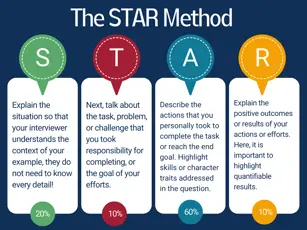Mastering the STAR Method: Do you Truly Understand the STAR Method
Do you often find it difficult to provide well-structured answers when interviewers ask about your past experiences? Nervousness can lead to stumbling over words and a lack of coherence. Using the STAR method to answer interview questions can help you avoid these issues and allow you to clearly demonstrate your experience and competence to the interviewer.
Today, Aniday will introduce you to the STAR method in this blog post, which has been proven successful and is highly regarded by HR professionals in Fortune 500 companies. I'll also explain how to use this technique in practical interviews.
What are Behavioral Interview Questions?

The STAR method is particularly effective for answering behavioral interview questions. These questions are designed to assess how candidates are likely to perform in job-related situations, helping the interviewer determine if the candidate is a good fit for the role. Here are a few examples:
1. Describe a significant problem you solved during your internship.
2. Provide an example of a situation where you had a different opinion, however, you managed to successfully persuade others.
3. What would you do if your plans were disrupted?
These questions typically focus on the candidate's past experiences, requiring them to provide specific examples rather than general descriptions of their previous work or internship. They aim to help the interviewer understand the candidate's personality and abilities, such as problem-solving, analytical skills, creativity, perseverance, writing, public speaking, teamwork, persuasion, and analysis.
Some interviewers structure their questions using the STAR method, and candidates can also use the STAR method to answer behavioral questions.
What Is the STAR Method?

The STAR method is an acronym for four key concepts, each of which represents a step for candidates to follow when answering behavioral interview questions. By following these four steps, candidates can provide comprehensive and logically structured responses. Let's break it down:
1. Situation (S): Describe the background, the environment you were in, or the challenges you faced at the time. For example, it could be a project you had never encountered before or a situation where there were no precedents for success within the company. Be as detailed as possible and relevant to the job you're interviewing for.
2. Task (T): Explain what your role or responsibilities were in that situation. For instance, you might have been the organizer or planner for a project that required exploring the unknown. Or you had to resolve disagreements with colleagues while trying to persuade them to consider your perspective, or you were responsible for achieving sales targets.
3. Action (A): Describe what you and your team did to overcome the challenge. Focus on what you did rather than what your team or colleagues did.
4. Result (R): Explain the outcomes of your actions and what you learned from the experience.
How to Use the STAR Method to Answer Behavioral Interview Questions

Since you won't know exactly what questions the interviewer will ask, it's a good idea to prepare a few impressive scenarios from your past work or internship experiences. If you don't have much work experience, consider your academic or extracurricular experiences that demonstrate your abilities.
1. List the skills and requirements for the job you're applying for.
2. Match your experiences and traits from your examples to the job requirements as closely as possible.
When preparing, you can also practice answering common behavioral interview questions using the STAR method. Some well-known companies, like Procter & Gamble (P&G), have a set of classic behavioral interview questions often referred to as the "P&G Eight Questions." These questions are a good starting point for practice.
STAR Method Examples
Example 1:
Interview Question: Can you provide an example of a task you had to complete within a short timeframe and how you handled it?
Response: While I generally prefer breaking my work into stages and completing it step by step, I can also deliver high-quality results in a short time. For example, a colleague left our team just a few days before a project was due. This project was entirely unfamiliar to anyone else (Situation). I was asked to take charge, and we had only three days left (Task). I formed a small team of two interns and assigned tasks. We worked through the night and completed the project in under two days (Action). I believe this experience demonstrates my ability to produce quality work in a short timeframe (Result).
Example 2:
Interview Question: How do you handle a situation where a team member refuses to complete their assigned task?
Response: When conflicts arise within a team, I always make an effort to lead the team effectively. I believe my communication skills are an asset in this regard. Once, during a team project, two members had a dispute because they were dissatisfied with their workload and refused to complete their parts (Situation). I realized that addressing their concerns was crucial to moving the team forward (Task). I organized a team meeting to understand each person's viewpoints, preferences and strengths and then reallocated tasks to ensure everyone was satisfied (Action). Ultimately, the project was a success, and it taught me the importance of fair task distribution in effective teamwork (Result).
In a Nutshell
The STAR method is a valuable tool for successfully navigating behavioral interview questions. By following this structured approach, you can provide clear, concise, and compelling answers that showcase your skills and experiences.
This method allows you to paint a vivid picture for the interviewer, demonstrating not only what you did in the past but also the positive results you achieved. As you prepare for your next interview, remember to match your experiences with the job requirements, practice with common behavioral questions, and craft well-structured responses.
With the STAR method in your toolkit, you'll be well-equipped to impress interviewers and increase your chances of landing your dream job. Good luck with your future interviews!
Aniday's HR Services
Headhunting Service
Find and recruit quality candidates in just 1 week! Supported by 40,000 experienced headhunters in IT, Finance, Marketing… capable of recruiting in any region.
Headhunting Service ➔Employer of Record (EOR) Service
On behalf of your business, we recruit employees and handle payroll without the need to establish a company in markets such as Vietnam, Singapore, Malaysia, India, Indonesia…
Employer of Record (EOR) Service ➔